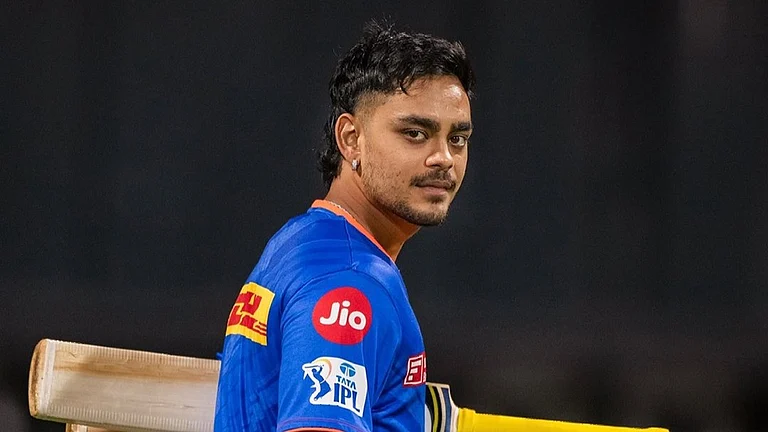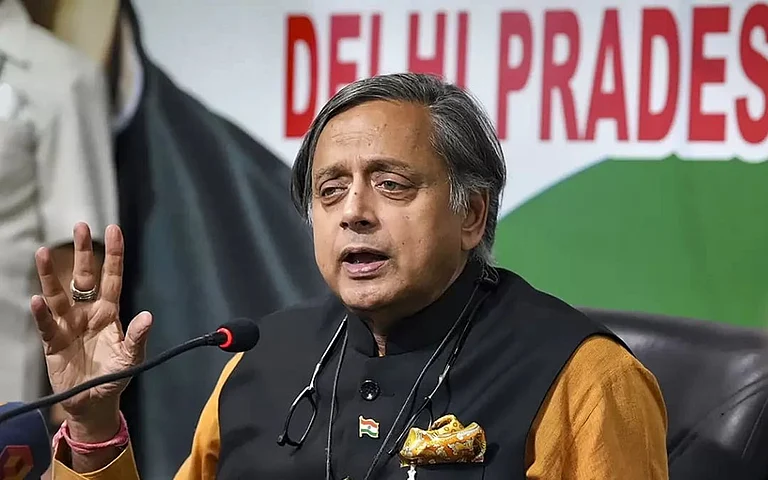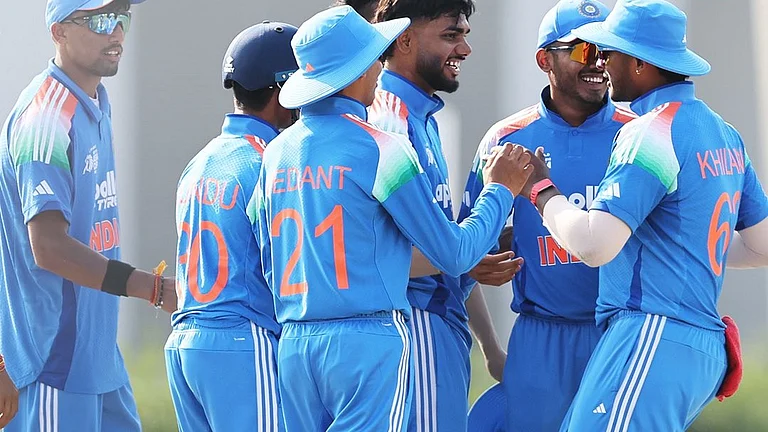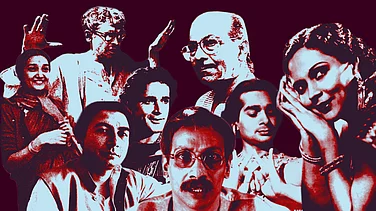Ashraf Sayed loves a good story. A custodian of earthquake folklore, he narrates a night in 1993 when cracks in the earth travelled over 14 miles from Killari in Latur only to be halted by the tomb of the patron saint of Nilanga, his village in Maharashtra. “For any story to be powerful,” the 64 year-old lightman in the Hindi film industry believes, “it needs to store dramatic memories, something unforgettable. Say…like the pandemic,” he points, “it reminded us that darkness always looms behind the camera. And light doesn’t always reflect.”
In Marol’s Chimatpada — one of the many colonies on the fringes of Mumbai’s Film City that supply body doubles, light crew and spot boys to surrounding film studios—work calls dried up as soon as the pandemic hit. Shoulders like Sayed’s that had supported the multi-billion dollar industry suddenly found themselves helpless, desperate and ignored. “All were left to fend for themselves. Everyone failed us, even the actors who came alive with our lights. That indifference shook us. We became our own sad movie…we learnt a blunt lesson,” he says, clutching a musical photo album that featured him with actors on film sets he had helped build.
“Bin-ticket Latur se aya tha” (I had travelled from Latur without a ticket), recalls Sayed, a seventh standard dropout, confirming the inter-generational script that early migrants to the city narrate of their first train journey to Bombay. His days would start with a bath at 4 am at the municipality hand pump under the Wadala sky, followed by a daily train ride to Bhayander metal yards, where he welded aluminium trunks to earn a daily wage of three rupees. “Tab Mira road sirf namak tha” (Mira Road was simply salt), he recalls. The windows of local trains offered moving sights to its migrants, even as its compartments—packed elbow-elbow— turned everyday encounters into strange reunions between a tired and toiling working class. On weekends it was Juhu-Chowpatty or Gateway — “Aajkal ka half chaddi nahi tha Bambai. Full pant pehente te tab log. Decent the.” (Unlike today’s shorts, men wore full pants in Bombay. They were decently dressed.)
After a decade of juggling one odd job after another, Sayed finally found himself behind a Jimmy Jib camera crane on a film set in Bombay. He felt good returning home having seen Salman Khan do a scene on a railway track. His daily wage: two crisp 100-rupee notes. Visuals in the 90s meant music video shoots, innovative film sets, Saroj Khan, heavy make-up, women in Amriki pants and a minimum of eight days shooting for a song sequence of six minutes. It was also the 90s when as a crane aid, he saw a woman director (Mira Nair) direct “a whole movie.” Finally, it was in 2000 during the shooting of Lagaan and Refugee—both films shot in Bhuj and surrounding villages in Kutch district of Gujarat—that Sayed held his first lights. Since then, he has held the lights that followed Jackie Chan’s acrobatics on wire, elevated the light atmosphere in iconic songs like ‘Dola Re’ from Devdas, reflected the starkness of the snow off an actor’s face in Russia and assisted multiple Indian and foreign crews overall.
On a movie set, a lightman takes instructions from the cameraman and is the most vital chain in a visual story; their deft eyes and hands fix the tone and texture of the movie through a variety of high key to low key light techniques. From holding camera magazines and reflectors dictating the ‘discipline of a shot’, to handling green screens and computers with assistant directors repeatedly ordering “one safety shot more, one safety shot more,” Sayed has seen it all. “When one shoots from a space of excess, it’s bound to reflect in the movie,” he says. “The language which only natural sunlight brought into a scene has gone. In the 90s and till the early 2000s, cameramen shot entire movies with camera magazines, so every person on set—from the director and the actors to the lightman—was in the loop. Every captured minute was precious and done perfectly within limited shots,” he adds.
Today, however, the pandemic has changed conversations from craft to survival. Once the lockdown was announced, pockets like Chimatpada survived through networks of brotherhood and “Cheques from Salman Khan, the lone actor who responded.” Even before the pandemic, Chimatpada didn’t have it easy; a new set of migrants were scooping the earth to build the city’s metro tunnel, and families above the ground listened to the sounds coming from several feet below their homes with their ears cocked to the floor at nights, as if trying to cajole the shuddering earth. Post pandemic, his neighbour—also a lightman— has lost his job to cost cutting. Another stunt actor is on call most days, having failed to get assignments. One lane behind him, a father of a production boy has died from lack of good health care. A spot boy has left to find a better job after payment cheques got delayed. Most youth in these lanes now have taken to feeding the city on their bikes.
It’s in such personal stories, he says, that everything matters. “You are standing alert all the time, sometimes through the twelve-hour shift.” Sayed has cleared just two cheques this month, of movies he did eight months ago. “The money doesn’t come fast anymore. And movie budgets don’t reach us. Unions also don’t voice our struggles.”
It’s not the same anymore, says the man whose two favourite movies still remain Jeena Ki Raah and Do Raaste. He stopped watching movies long ago—“Story kaha hain aaj kal?” (Where is the story these days?) On set, the men behind the cameras and cranes—the lightsmen and spot boys—predict if the movie will work. “Tajurba” he says, indicating his experience of having helped make movies.
Film sets, he says, are where people like him become invisible, and, at times, no amount of light helps. “Have you heard of Category B food—reserved for lighting and spot boys? The big hierarchies from director to make-up artists have Category A food, which has a variety of meat and vegetables; they are the ones for whom sturdy chairs are made available to sit and eat. Even their rice granules have a shape. By the time we come down from makeshift cabins built at 30 feet height, where the cranes hold light bulbs, we mostly have to stand as the chairs are all taken by those served Category A food. Our food is below average and kept separate, served in a different queue. Even the ice cream is sad—it’s runny and water-like. There is this really bad quality daal and the food doesn’t even appeal at times,” he says. “When it’s time to eat, we often try to ease the situation among us by joking that municipality food has arrived for us, for we are commoners. In the 90s and till a decade ago, all were equal. Everyone made the movie together,” he recalls.
“Budget is never discussed and it’s only in news reports we hear the crores in cost. At work, it’s difficult to eat when we hear such numbers. In fact it’s “Category B” who work harder and who should be treated a lot more humanely. I tell this to myself to ease the situation in my head.” As he walks past his neighbourhood, he points to the cranes that are working around his home. A survey number scrawled outside their homes is a promise they will be assigned a new house once the metro starts running.
“In the evenings, when we men and women come home from the sets we carry so many secrets from the sets. We hear and see things. These chawls are where those secrets come to die… in here live our stories. Even today I just work hard, finish my shift and come home to watch the news. Reality is starker these days,” says Sayed. “Movies don’t reflect our lives anymore.”
(This appeared in the print edition as "Stories in Light and Dark")
(Views expressed are personal)
Smita Nair is an independent journalist based in Bombay





















